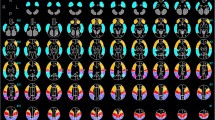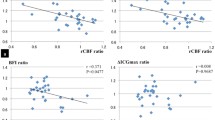Abstract.
The detection of subclinical abnormalities in cerebral blood flow could be of great value in identifying diabetic patients at risk of stroke. The aim of this study was to assess the contribution of semiquantified post-acetazolamide technetium-99m hexamethylpropylene amine oxime single-photon emission tomography (99mTc-HMPAO SPET) in 15 diabetic patients with no clinical history of central neurological disease. After baseline 99mTc-HMPAO SPET, a second SPET scan was acquired after activation of the cerebrovascular reserve (CVR) with an injection of 1 g of acetazolamide (post-ACZ SPET). Semiquantitative analysis was made in 16 regions of interest (ROIs) drawn for each of the three supratentorial slices selected, and in two ROIs in the infratentorial slice. The CVR was calculated in each ROI by subtracting the decay-corrected baseline images from those obtained in the post-ACZ SPET and expressed as the percent increase in the average counts between the two scans. Baseline perfusion and CVR values in the study group were compared with the corresponding values in a control group. Of 750 cortical ROIs studied, 332 showed a decreased CVR (44.3%). The baseline perfusion SPET study showed hypoperfusion in 65 ROIs (8.6%) and hyperperfusion in 56 (7.4%). Of the 65 hypoperfused regions, 66.2% had a normal CVR and 33.8% had a decreased CVR, whereas of the 56 hyperperfused regions, 51.8% had a CVR within normal limits and 48.2% showed a decreased CVR. In conclusion, in comparison with baseline 99mTc-HMPAO SPET, the ACZ activation test provided additional information in the study of cerebrovascular impairment, and allowed characterisation of the subclinical abnormalities in the population studied. The technique may therefore prove useful in evaluating future preventive strategies for stroke in diabetic patients.
Similar content being viewed by others
Author information
Authors and Affiliations
Additional information
Received 25 February and in revised form 3 June 2001
Electronic Publication
Rights and permissions
About this article
Cite this article
Jiménez-Bonilla, J.F., Quirce, R., Hernández, A. et al. Assessment of cerebral perfusion and cerebrovascular reserve in insulin-dependent diabetic patients without central neurological symptoms by means of 99mTc-HMPAO SPET with acetazolamide. Eur J Nucl Med 28, 1647–1655 (2001). https://doi.org/10.1007/s002590100595
Published:
Issue Date:
DOI: https://doi.org/10.1007/s002590100595




